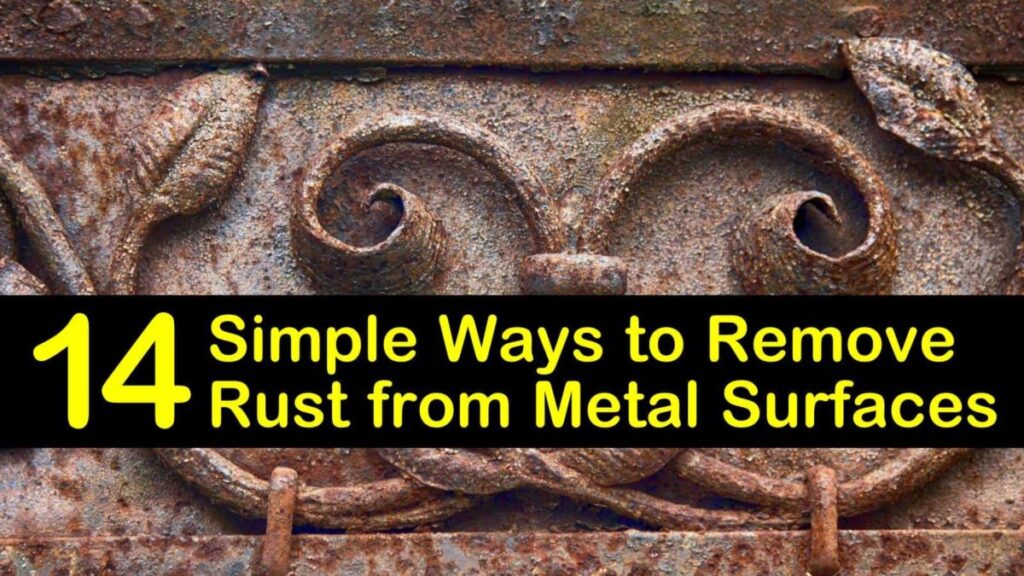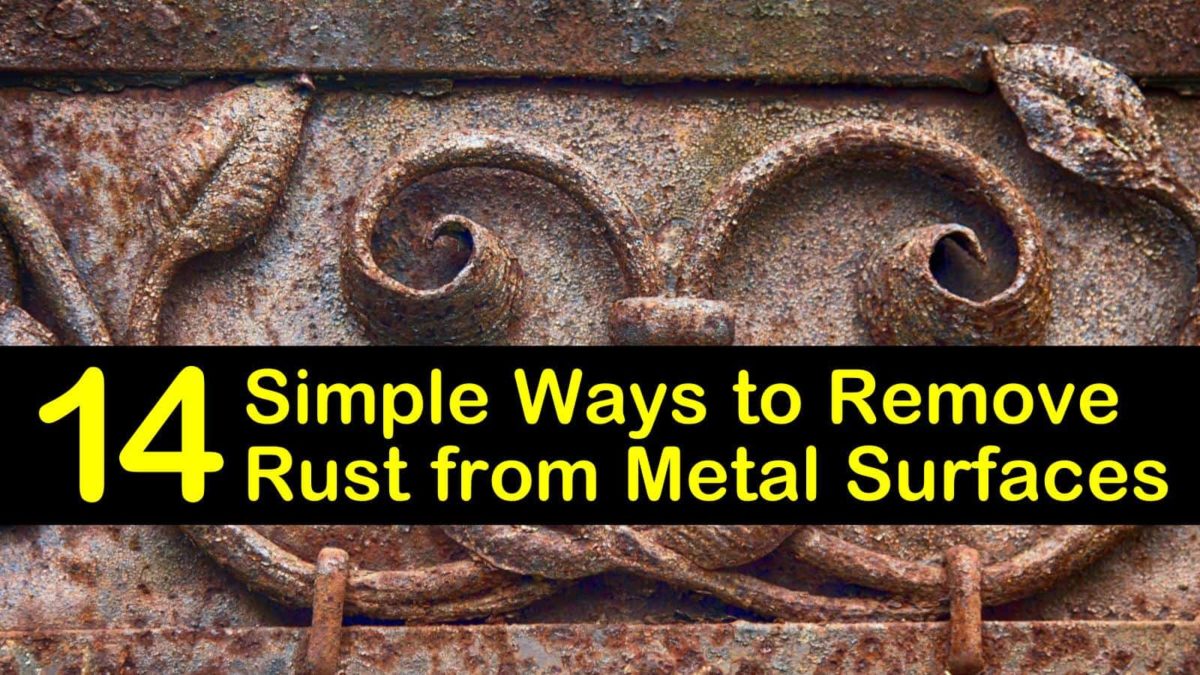
How Do I Clean Rust Off of Metal: A Comprehensive Guide
Rust, that reddish-brown flaky coating, is the bane of any metal object’s existence. It’s a form of iron oxide resulting from the electrochemical reaction of iron with oxygen in the presence of moisture. Understanding how to tackle this corrosive pest is crucial for maintaining the longevity and functionality of your metal possessions. This comprehensive guide explores various methods for effectively removing rust and preventing its return, answering the common question: how do I clean rust off of metal?
Understanding Rust: A Brief Overview
Before diving into the cleaning processes, it’s essential to understand what rust actually is. Rust isn’t just a surface blemish; it weakens the metal, eventually leading to structural failure. The oxidation process causes iron atoms to lose electrons, forming iron oxide. Unlike the protective oxide layer that forms on some metals (like aluminum), rust is porous and flaky, allowing further oxidation to occur. The presence of electrolytes, such as salt, significantly accelerates the rusting process. This is why cars in areas with salted roads are particularly susceptible to rust.
Safety First: Protecting Yourself
Before you begin any rust removal process, prioritize your safety. Always wear appropriate personal protective equipment (PPE), including:
- Safety glasses or goggles: To protect your eyes from flying debris and chemical splashes.
- Gloves: To protect your hands from sharp edges, abrasive materials, and harsh chemicals.
- Respirator or dust mask: To prevent inhalation of rust particles and chemical fumes, especially when sanding or using chemical rust removers.
- Appropriate clothing: Wear long sleeves and pants to protect your skin.
Work in a well-ventilated area, especially when using chemical rust removers. If you’re unsure about the safety precautions for a particular method or product, consult the manufacturer’s instructions.
Mechanical Methods: The Power of Elbow Grease
Mechanical methods involve physically removing the rust from the metal surface. These methods are often the most effective for heavy rust buildup and are generally less harmful than chemical methods. Here are a few common mechanical techniques to consider if you are thinking about how do I clean rust off of metal:
Sanding
Sanding is a versatile method for removing rust from various metal surfaces. You’ll need sandpaper with varying grits, starting with a coarse grit (e.g., 80-grit) to remove the bulk of the rust and gradually moving to finer grits (e.g., 220-grit, 400-grit) to smooth the surface. Power sanders can speed up the process, but be careful not to apply too much pressure, which can damage the metal. Remember to always work in a well-ventilated area and wear a dust mask.
Wire Brushing
Wire brushing is another effective method for removing rust, especially from irregularly shaped objects. You can use a hand-held wire brush or attach a wire brush to a power drill or grinder. Power tools make the job faster, but require more control to avoid damaging the metal. Again, wear safety glasses and a dust mask to protect yourself from flying debris.
Grinding
Grinding is a more aggressive method suitable for removing heavy rust and scale. Use a grinder with a grinding wheel or flap disc. Exercise extreme caution when using a grinder, as it can quickly remove metal. Wear safety glasses, gloves, and a face shield for maximum protection.
Abrasive Blasting
Abrasive blasting, such as sandblasting or media blasting, is a highly effective method for removing rust from large surfaces. This method involves propelling abrasive materials, such as sand, glass beads, or walnut shells, at high speed to remove rust and other contaminants. Abrasive blasting requires specialized equipment and training, so it’s often best left to professionals. [See also: Professional Rust Removal Services].
Chemical Methods: The Science of Rust Removal
Chemical rust removers use chemical reactions to dissolve or convert rust into a more manageable form. These methods are often less labor-intensive than mechanical methods, but require careful handling and proper ventilation. When considering how do I clean rust off of metal using chemicals, always read and follow the manufacturer’s instructions carefully.
Commercial Rust Removers
Numerous commercial rust removers are available in liquid, gel, and spray forms. These products typically contain acids or chelating agents that dissolve rust. Follow the manufacturer’s instructions carefully, as some products may require soaking the metal object for several hours. Always wear gloves and eye protection when handling chemical rust removers.
Vinegar
Vinegar, specifically white vinegar, is a mild acid that can effectively remove rust from small objects. Soak the rusty object in vinegar for several hours or overnight. The vinegar will react with the rust, loosening it from the metal surface. After soaking, scrub the object with a wire brush or scouring pad to remove the remaining rust. This is a great option for those wondering how do I clean rust off of metal using household items.
Lemon Juice and Salt
A mixture of lemon juice and salt can also be used to remove rust. Sprinkle salt on the rusty area, then squeeze lemon juice over the salt. Let the mixture sit for several hours, then scrub with a wire brush or scouring pad. The citric acid in lemon juice helps to dissolve the rust, while the salt acts as a mild abrasive.
Baking Soda
Baking soda, also known as sodium bicarbonate, is a mild abrasive that can help remove rust. Make a paste of baking soda and water, then apply it to the rusty area. Let the paste sit for several hours, then scrub with a wire brush or scouring pad. Baking soda is a gentle option that is less likely to damage the metal surface.
Oxalic Acid
Oxalic acid is a stronger chemical rust remover that is effective for removing heavy rust. It is often sold as a powder that needs to be mixed with water. Use oxalic acid with caution, as it is corrosive and can be harmful if inhaled or ingested. Always wear gloves, eye protection, and a respirator when using oxalic acid. Follow the manufacturer’s instructions carefully.
Phosphoric Acid
Phosphoric acid is another effective chemical rust remover that converts rust into a phosphate coating. This coating helps to protect the metal from further corrosion. Phosphoric acid is available in various forms, including liquid rust removers and metal etching solutions. Always wear gloves and eye protection when using phosphoric acid.
Electrolysis: The Science of Rust Removal
Electrolysis is a more advanced method of rust removal that uses an electric current to separate rust from the metal. This method is particularly effective for removing rust from intricate or hard-to-reach areas. Electrolysis requires a few basic supplies, including a plastic container, water, washing soda (sodium carbonate), a sacrificial anode (such as a piece of steel), and a battery charger. [See also: DIY Electrolysis Rust Removal].
Preventing Rust: A Proactive Approach
The best way to deal with rust is to prevent it from forming in the first place. Here are a few tips for preventing rust:
- Keep metal surfaces clean and dry: Moisture is a key ingredient in the rusting process, so keep metal surfaces clean and dry. Wipe down metal objects after exposure to moisture, such as rain or humidity.
- Apply a protective coating: Apply a protective coating, such as paint, wax, or oil, to metal surfaces to create a barrier against moisture and oxygen.
- Use rust inhibitors: Rust inhibitors are chemicals that slow down the rusting process. These products can be applied to metal surfaces to provide long-term protection.
- Store metal objects in a dry environment: Store metal objects in a dry, well-ventilated environment to minimize exposure to moisture.
- Consider using dehumidifiers: In humid environments, consider using dehumidifiers to reduce the moisture content in the air.
- Regular Inspections: Inspect metal objects regularly for signs of rust. Early detection allows for prompt treatment, preventing extensive damage.
Choosing the Right Method
The best method for removing rust depends on several factors, including the severity of the rust, the type of metal, and your personal preferences. For light surface rust, a simple mechanical method, such as sanding or wire brushing, may be sufficient. For heavy rust buildup, a more aggressive method, such as abrasive blasting or chemical rust removal, may be necessary. When in doubt, consult with a professional rust removal service.
Conclusion: Mastering Rust Removal
Rust is a common problem that can affect a wide range of metal objects. By understanding the causes of rust and using the appropriate removal methods, you can effectively restore your metal possessions to their former glory. Whether you choose mechanical methods, chemical methods, or electrolysis, remember to prioritize safety and follow the instructions carefully. And, most importantly, take proactive steps to prevent rust from forming in the first place. Now that you know how do I clean rust off of metal, you can confidently tackle any rust-related challenge and keep your metal objects looking their best. The key to success lies in understanding the different methods available and selecting the one that best suits your needs and resources. Remember that consistent maintenance and preventative measures are just as important as rust removal itself.

